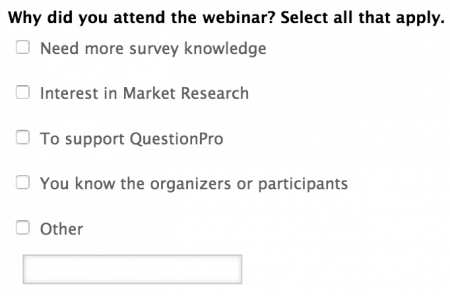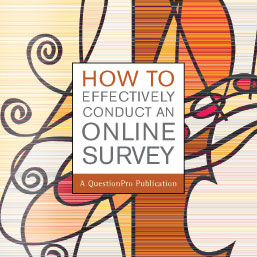15 Easy Ways to Increase Response Rates for your Survey
One of the most common questions we get asked is "how to increase response rates for surveys". There is no single answer for this problem you may have already tried one or two of the ideas on this list.
Online surveys have a lot of different purposes and can be a great way to receive feedback or helpful data, but only if you get good survey response rates. If you’re looking for demographic information or seeking reviews for your products or services, online surveys with high survey response rates can be a great way to accomplish just this and more. In order to make them worth your while, however, you need to make sure that your target audience is responding to your survey. The following are several helpful tips that will make people more likely to both take your survey as well as enjoy it in the process:
- Review the basic objectives of the study.
What are you trying to discover? What actions do you want to take as a result of the survey? This helps you double check the validity of the data collection mechanism. Online Surveys are just one way of collecting and quantifying perspectives.
- Target Your Audience
Consider a variety of sources for possible survey respondents. In addition to email mailing lists, for example, consider posting your survey to newsgroups and web communities.
- Personalize Your Email Invitations
Emails with a personal salutation result in increased response rates of at least five percent, and sometimes much higher. Send your email to "Dear Mr. Wright" rather than "Dear Valued Alumni."
Until Emails die, people will still check their emails for the foreseeable future. Improving a survey response rate should have two main focuses; increasing email clicks and reducing survey dropouts. To increase email clicks, the perceived barrier to filling out a survey should be minimal. One way to do this is to include the single most important question in the email itself.
Opening up an email and taking an action on the email content are two different things and are two distinct user interactions. As a marketer, you include call-to-actions in an email. Now, market researchers can have a better call to action by embedding the survey question visually in an email.
4 Best practices for embedding a embedding the survey question
- Choose a graphically prominent question type. An example would be to use an Net Promoter Score question instead of a Presentation text if it’s applicable.
- Ensure that the question text gives enough context and that the user doesn’t have to read it twice
- Don’t bait and switch. Typically you embed a single question and if there are many more follow-on questions, respondents will feel that you tricked them with a bait survey question. Ideally, limit the follow-on questions to 5 or less.
- Don’t forget to personalize the email. This could be by using the respondent’s name or with your thank you note at the bottom.
- Keep your email invitation short
Please keep your email invitation short and simple, with just one link - the one to the survey. Please be sure to explain the following:
- Who you are and the purpose of your study.
- The survey's benefit to the individual as well as to your business.
- Length of the survey. If it is short, emphasize that. But be truthful about times—people are more likely to stick with longer surveys if they know how much time they will take.
- Privacy statement, if required by your organization.
- Make your first survey page simple—let people take the survey!
Once people have decided to take your survey, they will want to get started. Studies show most people don't read extensive instructions.
- No survey surprises please – let them know it’s coming
Just like surveys are not the best of all journeys for customers, they also do not make for the best surprises. You will be better off informing them in advance that there is a monthly, quarterly or annual survey conducted. If you are a consumer good’s company, perhaps embed this message as an “FYI” in an invoice, newsletter or SMS to give them a heads up about what to expect and how it will benefit everyone.
- Use progress bars – inform customers where the finishing line is
Everyone likes to know how close they are to the finishing line. When it comes to surveys you really cannot use the phrase – “Focus on the journey and not the destination”. Because let’s be honest, it’s not really the most thrilling journey on the customer’s end. In their mind, they are doing you a favour by helping you make your product or service better when they can easily switch to another vendor in this highly competitive market.
The least businesses can do is let them know that progress is being made and they are inching closer to completion with every step. The sooner, the better. Suspense in this case can do a lot of damage when the customer feels that there is no end to the questions thrown at them. You have a much better chance of getting a complete response when your customers have a clear idea of how much time it will take to complete it and preserve time to do it.
- But? be clear about privacy protections
The first page of the survey is the place to include information about how you will be using people's responses. People are more comfortable sharing information on the Internet if they know how it will be used. Are they anonymous? Confidential? Shared with others? A university human subjects statement, if needed, would go here.
- Send reminder emails
Some people will take your survey right away. You will get increased responses, however, if you send follow-up email reminders with the survey link included. It is best not to send more than two reminder emails. Be sure to filter out email addresses of people who do not wish to be contacted again.
- Consider offering incentives—gifts, prizes, etc.
Studies show that incentives need not be large to increase response rates. A small token, gift certificate, etc., can increase responses considerably.
Our society has become rewards-driven in business, commerce, and our day-to-day; incentives are embedded within our society so much so that it has become a part of culture and expectations. These rewards are passed off to staff and packaged in wellness programs; they are plaques presented to sales reps for reaching quotas. They are the points we earn, the loyalty cards we shuffle in our wallets, and the frequent flier miles we stockpile; even bonuses and raises are forms of reward and incentive.
In marketing, rewards are indispensable tools. We donate portions of proceeds to causes. We employ games, contests, points, and loyalty cards– all to motivate specific behaviors. Incentives help businesses broaden word-of-mouth marketing, increase revenue, shrink advertising costs, expand into new markets, and keep customers coming back for more. Marketers use incentives because historically, they work. So why should this be any different for market research?
Without respondents, there is no data; without data, there is no research. This is why panel providers must incentivize their respondents fairly and act as ambassadors for their panelists. On the other hand, researchers must also be realistic and understand that the world has changed and consumers have evolved with society. Volunteer survey participants are almost extinct. High earning CEOs or influential individuals receive monetary incentives to give lectures, speeches, or to provide their expert opinions to various organizations. Their opinion is never questioned due to the value of their speaking fees. The correlation is direct—when researchers and survey companies start offering survey incentives, there will be an upward trend in survey response rate or data quality.
- Some people just want to share their opinion!
A large number of people will complete a survey to share their information rather than to receive an incentive. Consider making your incentive optional - you must choose to be included in a raffle or donating to a relevant cause for example.
- Use graphics and Internet features strategically.
Surveys generally don't need fancy graphics, and sometimes graphics can distract from the content of the survey, or influence answers. But there are a few ways to use graphics to improve your survey responses. These include providing an image and web link for a prize or incentive, using a multimedia embedded content survey.
- Publish your results online to survey participants.
People who respond will want to see results, and getting these results will encourage them to complete the survey.
- Follow up without sounding obsessive
Let’s be honest – between your customers and you, no one cares more about a successful feedback campaign than you. In these situations, it is quite easy for your executives responsible for the campaign to become rather obsessed about completion within the deadline and forget about customer approach.
An aggressive push like this may get some surveys completed as those customers might simply do it for the sake of getting your executives off their back. This leads to inaccurate data (if any), hinders customer participation in future surveys, marking your company as a spam and even discontinuation of services if pushed over the edge.
It is much better to add a gentle touch in reminders and re-emphasising why the survey is valuable from the customer’s perspective as well. If feasible, mix reminders into normal client calls as a “by the way we sent you a feedback” kind of approach that is more subtle in nature. Lastly, limit direct follow up calls for the extreme case, perhaps embed them in newsletters and emails instead.
- And a bonus?
Use friends, family and colleagues targeting ask your respondents to share your survey with people they know. Offer respondents an opportunity to send the survey to others, and if their friends and family take the survey, the original respondent has a better chance of winning/earning a gift incentive. Make sure to add a dedicated section to letting respondents share email addresses with you.
Two Features that will Increase Survey Response Rate
When was the last time you took a survey? Think back now, did you find yourself skipping the open-ended questions and just answering the multiple choice ones? If you skipped them, what do you think your respondents are doing? Not only that, but being a market research professional or marketing manager, you probably thought to yourself “That could have easily been a multiple choice question! Why are they being lazy and making ME write stuff down when they could have done a little more work and made this a multiple choice?!” Or am I the only one that thinks things like this?
The bottom line is that running multiple choice questions is a quick and easy way to increase your survey response rate and stop your customers or survey respondents from saying mean things about you under their breath or worse yet, dropping out of the survey.
Let me define the radio and check box button so that you know the difference
- Radio buttons: These are used when you want your respondent to only choose ONE response from a series of multiple choice responses. You’ll see a radio button when you select multiple choice questions and then select “choose one” . Here’s what that looks like:

- Check boxes: When you want to allow more than one selection as part of a multiple choice question, you’ll see a check box show up. It’s going to look like this:

Most survey practitioners will tell you to put more multiple choice questions in the beginning of your survey and then put open ended questions toward the end if you want to increase response rates. But what I think a lot of people do (based on the surveys I’ve taken) is they not only put open-ended responses at the end — they go bananas with too many Open-ended questions. This is exhausting and I’ve left more surveys than I care to mention because of this big mistake.
I highly recommend using as many multiple choice questions as you can in your survey. But don’t be lazy. Do some preliminary exploratory research in the form of conversations, phone calls, interviews, and social media engagement to get to the core of what questions to ask and what would be the appropriate choices to include.
Another way to increase response rates is to make sure you’re asking the right questions. Learn about the different Survey Question Types.
Survey Software Easy to use and accessible for everyone. Design, send and analyze online surveys.
Research Suite A suite of enterprise-grade research tools for market research professionals.
Customer Experience Experiences change the world. Deliver the best with our CX management software.
Employee Experience Create the best employee experience and act on real-time data from end to end.









